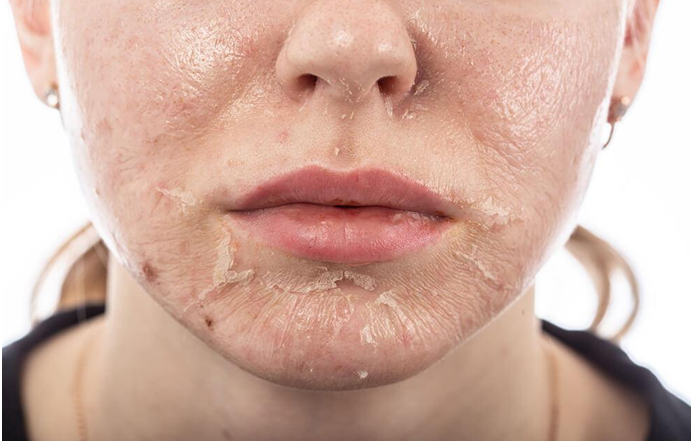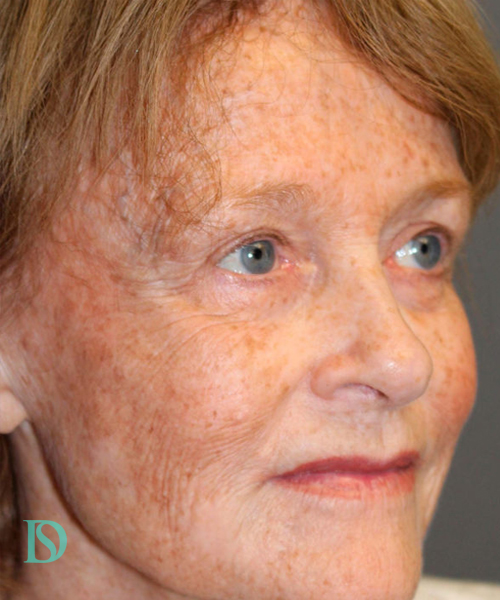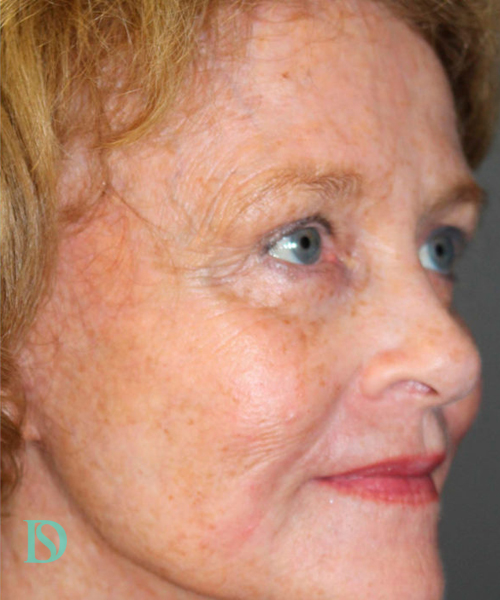Treatment at Derma Solution
Chemical Peels

Chemical Peeling
The treatment uses naturally occurring fatty acids and active ingredients to deeply exfoliate and brighten the skin. The treatment stimulates new cell growth and the production of collagen, leaving fresher, clearer and brighter skin. At Derma Solution, we offer a wide selection of industry-leading skin peeling. It involves applying a non-toxic chemical treatment to the skin that removes the top layer of dead skin cells and encourages new ones to grow, giving you softer, smoother skin.
How do skin peeling, chemical peeling and surface peeling work?
Peels and surface peels are designed to exfoliate your skin and make it regenerate by creating new skin cells. They also stimulate the skin’s natural production of collagen to improve fine lines and wrinkles.
Peeling treatments use acids and enzymes to exfoliate layers of the skin. A fresher, clearer and more youthful skin appears beneath the surface. Surface peeling is a milder form of skin peeling and is sometimes referred to as “superficial exfoliating treatment”.
The powerful blend of ingredients in skin peeling works by reducing the appearance of open pores, removing dead skin cells, impurities, acne and pigmentation and visibly smoothing fine lines and wrinkles. This procedure is used worldwide to treat skin problems such as fine lines and wrinkles, acne, hyperpigmentation and sun damage – the results can be life-changing.
What can I expect from the treatment?
- Rejuvenated and brighter skin
- Revival of dull skin
- Removal of dead skin cells
- Evens out skin texture and elasticity
- Reduces fine lines and wrinkles
- Smoother and softer skin
- Eliminates pigmentation and reduces the effects of sun damage
- Reduction of inflammation and breakouts caused by acne
- Moisturizes and nourishes the skin
- Stimulates the production of collagen for plumper and more youthful looking skin
To achieve maximum results, our skin experts will recommend a series of skin peeling treatments according to your skin type, elasticity and condition.
Book a consultation to discuss a customized treatment plan.
Treatment Summary
Procedure Time:
30 – 60 mins
Back to Work:
Immediate
Anaesthetic:
None
Full Recovery:
0 – 14 days*
Sensitivity Period:
0 – 7 days*
Duration of results:
Long-lasting results*
Risks and Complications:
Redness, irritation, Inflammation, Peeling
Book Now:
Procedure Time:
30 - 60 mins
Back to Work:
Immediate
Anaesthetic:
None
Full Recovery:
0 – 14 days*
Sensitivity Period:
0 – 7 days*
Duration of results:
Long-lasting results*
Risks and Complications:
Redness, irritation, Inflammation, Peeling
Book Now:


Price GuaranteeOn All Treatment
Derma Solution offers a price guarantee on all of our treatment ranges. If you are able to find a treatment that we offer cheaper anywhere in Copenhagen we will match the price.
Chemical Peels
Treatment Prices
-
Technoceuticals® Level 1 DKK 1.095
-
Technoceuticals® Intensive Peel 5 (IP5) Level 2 DKK 1.195
-
Technoceuticals® Retinol Dual Phase Power Peel Level 3 DKK 1.295
-
Consultation DKK 0.00
Chemical Peels
Frequently Asked Questions
We achieve the best results when we use peeling for sun damaged skin and acne scars. Peeling has proven to be highly effective on the fine and fair Scandinavian skin, which tends to be strongly affected by the sun and aging. Sun damage can be reduced and, in this case, both the complexion and structure of the skin are improved and give the skin a smoother and more uniform appearance.
If you have hyperpigmentation, you will probably experience an improvement already after the first treatment. In general, it is recommended to plan a course of 3-4 treatments at intervals of a few weeks to achieve maximum effect.
Acne scars, wrinkles and fine lines around the eyes etc. can also be reduced with peeling. Peeling works perfectly together with other treatments to reduce scars and wrinkles – we often tailor long-term programs for our clients. We see the best results when you combine several types of treatments in one program.
The result from peeling is permanent, so small signs of ageing, small spots or a serious skin problem can be improved forever. After that, it’s just a matter of caring for the skin to maintain the beautiful result.
Depending on the type of peel used, you may require a consultation.
The skin must be clean and whole – there must be no wounds or tears where the skin is to be peeled.
The peeling is a multi -step process. First, the skin is thoroughly cleansed, which is followed by a particularly active exfoliation, before the peeling itself is applied as a mask to the treatment area. It can be on the face, neck or chest – areas where the skin is delicate and small pigment changes or scars stand out. The peeling may sting the skin a little and may feel warm.
After the actual peeling, the skin is treated with stimulating, soothing and building products that balance the skin. Right after the peeling, the skin is smooth, moisturised, more uniform and with a fantastic glow.
To take care of your newly treated skin, use factor SPF 50+ for a few weeks after your treatment. Your therapist will also recommend nourishing creams that you should use after your peeling to nourish and maintain the effect.
Chemical peels are used to treat certain skin conditions or to improve your appearance by improving the tone and texture of your skin.
Chemical peels are most commonly performed on your face, neck or hands. They can help reduce or improve:
- Fine lines under your eyes or around your mouth and wrinkling caused by sun damage, aging and hereditary factors.
- Certain types of acne.
- Mild scarring.
- Sun spots, age spots, liver spots, freckles, uneven skin colouring.
- Precancerous scaly spots called actinic keratosis.
- Rough skin, scaly patches, dull complexion.
- Dark patches (melasma) due to pregnancy or taking birth control pills.
You will work with your dermatologist to determine the depth of your peel. This joint decision can vary depending upon the condition of your skin and the objectives of treatment.
Sags, bulges, deep scars, deep facial lines and more severe wrinkles don’t respond well to chemical peels. If these are your concerns, other cosmetic surgical procedures, such as carbon dioxide laser resurfacing, a face lift, brow lift, eye lift or soft tissue filler will be better options. A dermatologic surgeon can help determine the best treatment for your concerns.
Generally, superficial peels can be used on all skin types. However, if you have a darker skin tone, you have a greater risk of experiencing a darkening of your skin after treatment. This condition is called post-inflammatory hyperpigmentation. If you have a naturally darker skin tone, you may want to get the advice of your dermatologist about other less aggressive treatments to reduce the risk of hyperpigmentation.
Chemical peeling may also not be recommended if you:
- Have a history of abnormal skin scarring.
- Have extra coloring in your scars.
- Have skin conditions or take medications that make your skin more sensitive.
- Can’t stay out of the sun for the healing period.
A chemical peel can be performed in a doctor’s office or in a surgery center as an outpatient procedure. Your skin will be thoroughly cleansed with an agent that removes excess oils, while your eyes and hair are protected. A chemical solution is then applied to your skin. Chemical solutions typically used include glycolic acid, trichloroacetic acid, salicylic acid, lactic acid or carbolic acid (phenol). The different types of chemicals cause a controlled injury, each penetrating through to a different skin depth, then peeling away to reveal a new layer of skin.
The different chemical solutions provide different results. The choice of chemical depends on your goal. You will work with your dermatologist to determine the depth of your peel.
- A light (“lunchtime”) chemical peel provides subtle improvement over time and is often done in a series. The outermost layer of skin is removed. This choice may be best if you have fine wrinkling, acne, uneven skin coloring or dry, rough sun-damaged skin to help promote a healthy glow. Recovery from this type of peel may be within hours to a few days but with little to no down time.
- A medium chemical peel gives your skin a smooth, fresh look. The outermost layer and the upper part of your middle skin layer are removed. This choice may be best if you have uneven or moderate skin discoloring, age spots, acne scarring or fine-to-moderate wrinkles. Recovery from this type of peel may take a week or more and require some down time.
- A deep chemical peel produces the most dramatic results. This chemical penetrates down to the lower middle layer of your skin. Recovery time is longer with a deep peel. This choice may be best if you have moderate lines and wrinkles, extensive sun-damaged skin, deep acne scars, blotchy skin, and/or precancerous growths called actinic keratosis. A deep chemical peel requires pretreatment for up to eight weeks. Your doctor will provide specific instructions. A deep chemical peel is a one-time only treatment if applied to your face and does have significant down time.
To prepare for your chemical peel, some general instructions include:
- Avoid tanning and direct sun exposure for two weeks before each treatment.
- Apply topical products (such as hydroquinone) as instructed before treatment to prepare your skin.
- Don’t use any products containing retinoids (such as tretinoin) one to two weeks before treatment, unless your physician tells you differently.
- If you have been prescribed oral antibiotics or an oral antiviral medicine, start taking it at least 24 hours before your chemical peel.
- Peel areas must be free of any open sores, lesions or skin infections.
Your doctor will give you specific instructions for your peel type and your unique skin condition.
Day of peel: Your skin will be thoroughly cleaned. If you are having a deep chemical peel, you will receive general anaesthesia (you will be asleep).
The procedure: During a chemical peel, solution is applied to your skin. You may feel a warm to somewhat hot sensation that will last a few minutes. This is followed by a stinging sensation. To relieve the sting, a cool compress may be applied your skin. The chemical is then washed off and/or neutraliser.
What should I expect after the chemical peel?
What to expect varies depending on the depth of your chemical peel.
If you’ve had a light chemical peel:
- Expect a sunburn-like reaction to occur after your peel, meaning you’ll see redness followed by scaling that lasts between three and seven days.
- Apply lotion or cream as directed until your skin heals. After your skin heals, apply daily sunscreen.
- You can wear makeup immediately after treatment or the next day.
- Additional peels may be repeated every two to five weeks until you achieve your desired results. Typically three to five peels are needed to achieve your goal.
If you’ve had a medium chemical peel:
- Expect some redness, swelling, stinging and flaking of your skin. Swelling may last and/or worsen for 48 hours. Blisters can develop and will break open. Skin will crust and peel off over seven to 14 days.
- Perform daily soaks as directed by your doctor. Apply ointment after each soak. Apply lotion or cream daily. Don’t expose your skin to sunlight until completely healed.
- Antiviral medication will need to be taken for 10 to 14 days.
- You can wear makeup after five to seven days.
- Additional medium-depth peels may be repeated at six to 12 months intervals, if needed, to maintain results.
If you’ve had a deep chemical peel:
- The treatment area will be bandaged. Your bandages will be removed in a few days. Expect a healing time of 14 to 21 days.
- Perform daily soaks as directed by your doctor. Apply ointment after each soak. After 14 days, apply moisturizer as directed. Don’t expose your skin to sun for three to six months.
- Antiviral medication will need to be taken for 10 to 14 days.
- Wait at least 14 days before using any makeup.
- You can only have one deep peel performed on your face.
To get the best results, regardless of the depth of your peel, follow these tips:
- Don’t use a tanning bed or other type of indoor or even outdoor tanning while your skin is healing.
- After your skin heals, always apply a daily sunscreen.
- Apply a daily moisturizer, as directed, to keep your skin moist to prevent scarring.
Your new skin is fragile and more susceptible to complications. Your doctor will provide you with post-treatment instructions to reduce the chance of developing abnormal skin color after your peel and other complications.
If your skin itches, swells or burns, call your doctor. Scratching your skin could lead to an infection.



